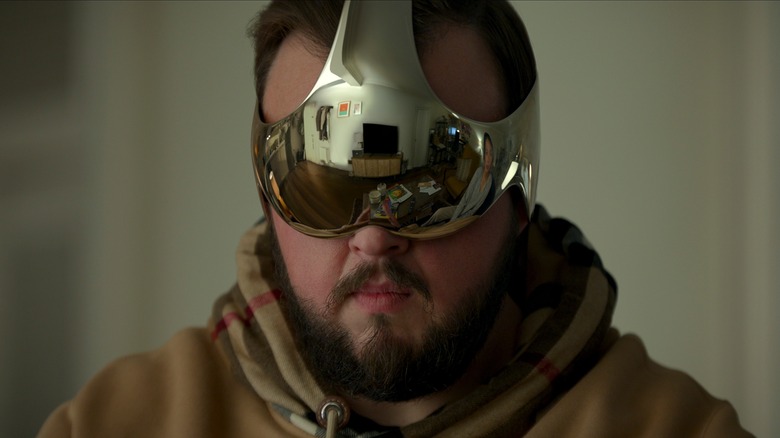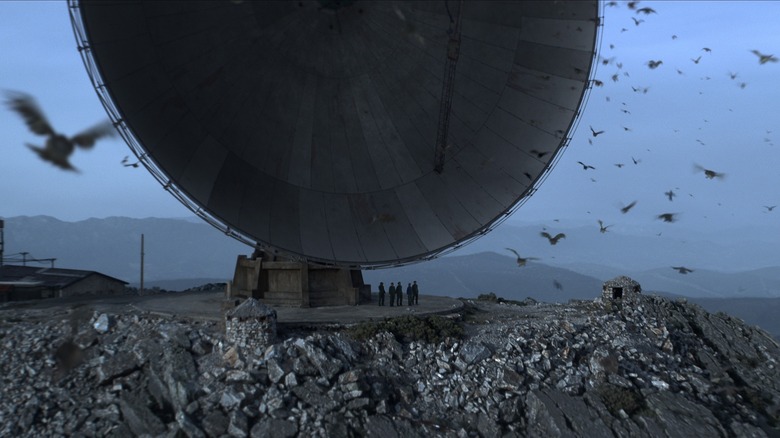Breaking Down The Real-Life Accuracy Of Netflix's 3 Body Problem
This article contains spoilers for the entire season of "3 Body Problem."
Against all odds, a new adaptation of the acclaimed sci-fi novel "The Three-Body Problem" is finally here and it truly lives up to its billing as the nerdiest series of the year. (For more on that, check out my review of Netflix's "3 Body Problem" here.) Readers know full well just how deep in the weeds the original story can get, as author Liu Cixin oftentimes spends entire passages breaking down the finer points of astrophysics, quantum mechanics, and other heady STEM topics that definitely aren't for the faint of heart. It's to the writer's credit that even the driest of subject matter still provides a foundation for one of the most entertaining epics in all of fiction, made up of a full trilogy of books collectively titled "Remembrance of Earth's Past," thanks in no small part to his commitment to getting the science right wherever possible. In short, Cixin envisions an impending alien invasion that's much closer to the likes of "Interstellar" or "Arrival" than "Independence Day."
Although the Netflix adaptation takes plenty of liberties with the source material, the spirit of the original shines through in "3 Body Problem" — perhaps nowhere as clearly or more faithfully than its handling of the sci-fi that's so integral to the story. In the first few episodes alone, we witness an unprecedented cosmic "blink," virtual-reality technology that puts the metaverse to shame, and, of course, the real-world physics problem that gives the series its name. From aliens to artificial intelligence and everything in between, viewers may be surprised to find out just how accurate (or close enough, at least) many of the concepts of "3 Body Problem" truly are. Let's break it down.
Dear aliens (who art in heaven)
For as much real estate as it takes up in our biggest movies and shows (shout out to Wes Anderson's delightful "Asteroid City" and its banger original song), the concept of extraterrestrial life actually existing somewhere out in space tends to get dismissed out of hand, right alongside Bigfoot or Loch Ness monster conspiracy theories. This mindset may have even factored into the marketing of "3 Body Problem," where the trailers went to considerable lengths to hide the fact that the story has anything to do with humanity attracting the attention of an advanced civilization at all. Luckily, we here at /Film are proud to exclusively break the news that aliens do, in fact, exist. You heard it here first, folks!
Fine, we can't quite go that far and definitively state that humanity truly isn't alone in the universe (not yet, at any rate), but this is much less fantastical than the average layperson might assume. While we're not likely to discover Decepticons hidden on the other side of the Moon or Martians attacking in tripods who happen to have a weakness for the common cold, agencies like NASA sure are devoting significant amounts of resources to find remnants of microbial life on Mars or traces of habitable conditions on distant worlds. And then there's the simple math of it all: If life managed to spring into existence on our random planet circling our little sun, and there are billions of stars hosting planets of their own in our galaxy alone, and there are billions and possibly trillions of galaxies in the known universe ... personally, I like those odds.
Even if the majority of events in "3 Body Problem" remain firmly in the realm of imagination, its fascinating premise is anything but.
The three-body problem
Settle down, class, because today's lesson is all about advanced orbital mechanics. Movies like "The Martian" or "Apollo 13" go a long way towards revealing just how difficult and dangerous space travel is to fragile human bodies and the chemical bombs we ride in to get there (fun fact: that's basically what rockets are), but they don't even scratch the surface of how complex space really is.
That brings us to one of the fundamental puzzles in all of astrophysics and the central idea behind the Netflix series: the three-body problem. It's (relatively) easy to understand how the orbits of two distinct cosmic entities affect one another like, say, the Earth traveling around our sun or a pair of stars (known as a binary system) endlessly rotating around each other. Two bodies, two orbits. Simple math. But once you introduce a third variable into the equation, well, suddenly things start to get downright wonky. For reasons I'm not nearly smart enough to understand, any system of three bodies in close proximity with one another presents an unsolvable problem for anyone trying to carefully map out their exact orbits.
In "3 Body Problem," this takes on galactic stakes with the extraterrestrials known as the San Ti, whose planet is caught in a gravitational tug-of-war between three stars. The virtual-reality game visualizes this environment to dramatic effect for our protagonists, emphasizing just how hellish life would be on such a world and neatly explaining why such a civilization would be eager to flee and colonize the nearest habitable planet. Astronomers have actually observed systems like this before (minus the unruly aliens, of course), confirming that conditions on the surface would be as chaotic as we'd imagine and making this otherworldly scenario — believe it or not — perfectly plausible.
The Staircase Project
File this under the category of "Things I Never Expected to See in Live Action." In the third book, titled "Death's End," author Liu Cixin comes up with one of the most unbelievable plot developments in the entire trilogy (which, believe me, is saying a lot.) In order to learn about the alien fleet that's already well on its way to Earth, a desperate plan is hatched to send a probe to intercept the advancing forces and gain intel on their enemies. As for who would actually be crazy enough to volunteer for such a mission? Someone with a terminal illness and an existential need to do something meaningful with their life, of course. And, incredibly enough, "3 Body Problem" adapts this entire subplot with almost complete fidelity through the character of Will Downing (Alex Sharp).
But what about scientific accuracy, you say? Not to burst anyone's bubble or anything, but humanity obviously hasn't yet managed to come up with a way to perfectly flash-freeze someone's brain, load it up onto a rocket, and use the precise detonation of hundreds of atomic bombs to blast it light-years away in order to be studied by our eventual alien overlords. Even the biggest fans of the books would admit that this is one of the more imaginative sequences in the story, although it helps that the characters themselves — primarily Thomas Wade (Liam Cunningham) — share our skepticism. Nobody really expects such a scheme to work ... although at least the logistics behind the "nuclear pulse propulsion" aspect are actually theoretically sound, based on a real-world government effort called Project Orion.
Otherwise, however, this is one of the instances in "3 Body Problem" where the "fi" in sci-fi ultimately wins out.



